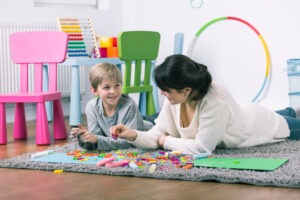Swing…stop…sleepy…store. “S” is surely an important sound for a child to be able to articulate!
However, it’s common for children to have trouble producing the “S” sound. It can also be a difficult speech sound error for a child to correct, and may require an extra special “bag of tricks” from parents and Speech Therapists who are working with the child.
Here are some common things that go wrong when children try to make the “S” sound, and some pro tips for helping a child master this sneaky sound!
S Articulation Errors
Children are typically able to articulate the S sound by age 4, according to the American Speech-Language Hearing Association (ASHA).
What does it sound like when a child has trouble making an S sound?
One common error is known as a lisp.
There are actually two different types of lisps – interdental and lateral.
An interdental lisp occurs when a child’s tongue protrudes forward, between their teeth (similar to a TH sound) when he or she attempts to make an S sound.
A lateral lisp occurs when air escapes over the sides of a child’s tongue into the cheeks. The air and saliva in the sides of the cheeks make the S sound “slushy”, and this error can be a little trickier to correct.
Children can make other errors when attempting to make an S sound. For example, a child might substitute it with a T or D sound (known as a phonological process called stopping).
Sometimes when the S is accompanied by another consonant sound (known as a consonant cluster), a child will leave off the S sound completely, like saying “poon” for “spoon”).
Children might also substitute the 2 sounds in an “S” conant blend for a completely different sound (for example, “foon” for spoon).
There really are a lot of things that can go wrong when a child tries to make this sound. Now, what are some ways to teach children to master the S sound?
#1: Watch This
Show him or her what it looks like when you make an “S”. Explain how the muscles in your mouth move when you make the sound.
For example, “I put my tongue up almost to the roof of my mouth and make a little groove in the middle. Then, I make a little stream of air come through the middle of my mouth between my teeth!”.
Here are some ways you can give a child helpful visuals:
- Sit face to face and encourage him/her to watch your mouth.
- Use a mirror for the child to watch as he or she makes the “S” sound.
- Demonstrate correct oral motor positioning with a mouth puppet (like this one).
- Show YouTube articulation videos, like this one from Peachie Speechie.
#2: Turn a Long “T” into “S”
Here’s a clear, effective technique for teaching a child with a lisp how to make an “S” sound correctly. It’s known as the “Long”T ” Method”, and has been recommended by the well-known SLP Pamela Marshalla.
- Make sure the child can make a “T” sound.
- Now, ask the child to make a “T” but to stretch out the sound or blow air for longer at the end of the sound.
- Show the child how to do this, making an elongated, exaggerated “T” sound.
- Ask the child to make a “long “T” sound” again, this time lifting the tip of the tongue up to the roof of their mouth.
#3: The Butterfly Position/Aspiration Trick
#4: Use Fun Sound Associations!
Follow the typical hierarchy of teaching a sound; start by helping the child make the sound by itself (in “isolation”). Then, have the child practice the sound in a certain position of simple syllables (ex: beginning or end). After that, it’s words, phrases, and sentences!
- Rattlesnake Jake game
- Sneaky, Snacky Squirrel game
- Silly Sally book
- Play in a sandbox
- Name pairs of objects as same or different
- Take a walk and play, I Spy
Additional Resources
The “S” sound can be a tricky one for children and parents to tackle without the help of a speech language pathologist! Because an articulation disorder can affect how well others can understand a child at home, school, and around their peers, it’s truly important to address. With a few specialized techniques, your child can master the “S” sound!
If you have concerns about your child’s speech and language skills, specialized services from a Speech-Language Pathologist can help. An initial evaluation can help determine what difficulties your child is having. Ongoing individualized therapy can include techniques and activities to help improve these areas.
TherapyWorks offers speech therapy, occupational and physical therapy both in person (in Illinois, Michigan, and Ohio) and through teletherapy (nationwide). If you would like to learn more, or discuss your child’s specific needs, please don’t hesitate to reach out to TherapyWorks!








